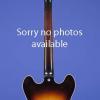This thirty-seven-year-old Sunburst Custom beauty weighs 7.30 lbs. and has a nut width of just over 1 5/8 inches and a scale length of 25 1/2 inches. Single-bound solid alder body, maple neck, and veneer rosewood fretboard with 21 frets and pearloid dot dot position markers. Single "butterfly" string tree with nylon spacer. Headstock decal with "Fender" logo in gold with black trim, "Esquire" in black below it, and "PAT. 2,573,254 3,143,028" in black below that. Individual Fender "F" tuners with octagonal metal buttons. Four-bolt neck plate with large Fender backward "F" logo and with serial number ("218735") between the top two screws. One single-coil pickup, angled in bridgeplate. Three-layer (white/black/white) plastic pickguard with eight screws. Two controls (one volume, one tone) plus three-way "tone" switch with "top-hat" tip, all on metal plate adjoining pickguard. Chrome knobs with flat tops and knurled sides. The neck is stamped "3 523 129B" (December 1969) and the pots are dated "137 6642" (CTS October 1966). The lovely grain of the alder body shows very well through the Sunburst finish, and taking into account a small mark (with surface loss) on the upper bass bout, a few other small marks on the top, a few minor edge marks, and the usual wonderful finish checking, this thirty-seven-year-old gem is one of the very best Custom Esquires we have ever seen. Housed in its original Fender black hardshell case with dark orange plush lining (9.00). The price in July 1968 was $224.50 (without Bigsby) for the guitar (only $5.00 less than a Telecaster…and a full $30.00 more than the regular Esquire), plus a huge $57.50 for the case!
"Leo Fender's new solidbody was the instrument that we know now as the Fender Telecaster, effectively the world's first commercially successful solidbody electric guitar...The guitar was originally named the Fender Esquire and then the Fender Broadcaster, and it first went into production in 1950. It was a simple, effective instrument. It had a basic, single-cutaway, solid slab of ash for a body, with a screwed-on maple neck. Everything was geared to easy production. It had a slanted pickup mounted into a steel bridge-plate carrying three adjustable bridge-saddles, and the body was finished in a yellowish color known as blond. It was unadorned and like nothing else. It was ahead of its time. (Tony Bacon, 50 Years of Fender, p. 10).
"After a false start the Esquire reappeared...in 1951, now with Fender's new adjustable truss-rod. It was offered in single-pickup format only, but otherwise was virtually identical to the two-pickup Telecaster. However, the Esquire's three-way selector functioned as a preset tone control or bypass switch, offering wide versatility from a one-pickup guitar. Perhaps surprisingly, the Esquire stayed in the line for 20 years" (Tony Bacon and Paul Day, The Fender Book, p. 10).
"The June 1959 NAMM convention held in New York saw the debut of the TELECASTER and ESQUIRE CUSTOM. Intended as a deluxe version of the regular models, they were characterized by what Fender called 'the custom treatment of the body,' i.e. a sunburst finish with a contrasting white binding and a triple-ply white pickguard. Otherwise, with the exception of an alder body, their basic appointments were identical to the mid-59 'standard' Telecaster and Esquire models" (A.R. Duchossoir, The Fender Telecaster, pp. 19-20).
Translate:

